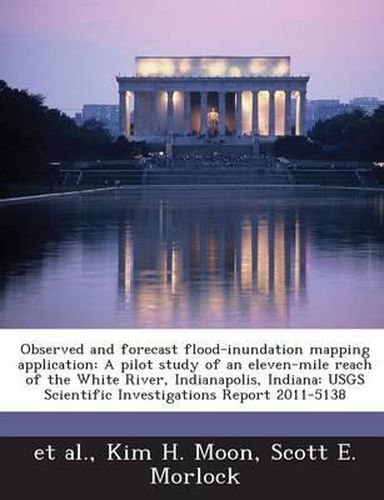Readings Newsletter
Become a Readings Member to make your shopping experience even easier.
Sign in or sign up for free!
You’re not far away from qualifying for FREE standard shipping within Australia
You’ve qualified for FREE standard shipping within Australia
The cart is loading…






Near-real-time and forecast flood-inundation mapping products resulted from a pilot study for an 11-mile reach of the White River in Indianapolis. The study was done by the U.S. Geological Survey (USGS), Indiana Silver Jackets hazard mitigation taskforce members, the National Weather Service (NWS), the Polis Center, and Indiana University, in cooperation with the City of Indianapolis, the Indianapolis Museum of Art, the Indiana Department of Homeland Security, and the Indiana Department of Natural Resources, Division of Water. The pilot project showed that it is technically feasible to create a flood-inundation map library by means of a two-dimensional hydraulic model, use a map from the library to quickly complete a moderately detailed local flood-loss estimate, and automatically run the hydraulic model during a flood event to provide the maps and flood-damage information through a Web graphical user interface. A library of static digital flood-inundation maps was created by means of a calibrated two-dimensional hydraulic model. Estimated water-surface elevations were developed for a range of river stages referenced to a USGS streamgage and NWS flood forecast point colocated within the study reach. These maps were made available through the Internet in several formats, including geographic information system, Keyhole Markup Language, and Portable Document Format. A flood-loss estimate was completed for part of the study reach by using one of the flood-inundation maps from the static library. The Federal Emergency Management Agency natural disaster-loss estimation program HAZUS-MH, in conjunction with local building information, was used to complete a level 2 analysis of flood-loss estimation. A Service-Oriented Architecture-based dynamic flood-inundation application was developed and was designed to start automatically during a flood, obtain near real-time and forecast data (from the colocated USGS streamgage and NWS flood forecast point within the study reach), run the two-dimensional hydraulic model, and produce flood-inundation maps. The application used local building data and depth-damage curves to estimate flood losses based on the maps, and it served inundation maps and flood-loss estimates through a Web-based graphical user interface.
$9.00 standard shipping within Australia
FREE standard shipping within Australia for orders over $100.00
Express & International shipping calculated at checkout
Near-real-time and forecast flood-inundation mapping products resulted from a pilot study for an 11-mile reach of the White River in Indianapolis. The study was done by the U.S. Geological Survey (USGS), Indiana Silver Jackets hazard mitigation taskforce members, the National Weather Service (NWS), the Polis Center, and Indiana University, in cooperation with the City of Indianapolis, the Indianapolis Museum of Art, the Indiana Department of Homeland Security, and the Indiana Department of Natural Resources, Division of Water. The pilot project showed that it is technically feasible to create a flood-inundation map library by means of a two-dimensional hydraulic model, use a map from the library to quickly complete a moderately detailed local flood-loss estimate, and automatically run the hydraulic model during a flood event to provide the maps and flood-damage information through a Web graphical user interface. A library of static digital flood-inundation maps was created by means of a calibrated two-dimensional hydraulic model. Estimated water-surface elevations were developed for a range of river stages referenced to a USGS streamgage and NWS flood forecast point colocated within the study reach. These maps were made available through the Internet in several formats, including geographic information system, Keyhole Markup Language, and Portable Document Format. A flood-loss estimate was completed for part of the study reach by using one of the flood-inundation maps from the static library. The Federal Emergency Management Agency natural disaster-loss estimation program HAZUS-MH, in conjunction with local building information, was used to complete a level 2 analysis of flood-loss estimation. A Service-Oriented Architecture-based dynamic flood-inundation application was developed and was designed to start automatically during a flood, obtain near real-time and forecast data (from the colocated USGS streamgage and NWS flood forecast point within the study reach), run the two-dimensional hydraulic model, and produce flood-inundation maps. The application used local building data and depth-damage curves to estimate flood losses based on the maps, and it served inundation maps and flood-loss estimates through a Web-based graphical user interface.